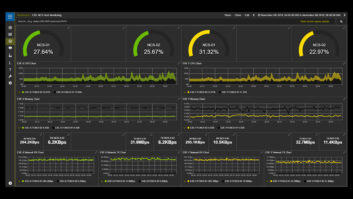
SDI is the traditional broadcast way of moving video around, but for Ultra HD no SDI standard has yet been agreed. Although there is work being done on a single-cable 12Gbps standard, it will be some time before this is in use. Meanwhile, IP-based technology is already being used for 4K production, so could the transition to UHD be the ideal opportunity to move on from SDI cables to an internet protocol-based system.
Creating a version of SDI to carry UHD “will be pushing the boundaries” of what the technology can handle, according to Jan Eveleens, CEO, Axon Digital Design. “Cable length will definitely be a challenge and it will remain a very limited, circuit-switched, unidirectional, very industry-specific interface with a minimal cost erosion curve.”
“SDI will be able to handle UHD” said Paul Shen, CEO of TVU Networks. “However, SDI remains a one way, single-purpose, and point-to-point connection. 4K will provide a natural point for broadcasters to transition to a more flexible interface.”
IP technology is also advancing much faster than SDI. Ethernet is already moving towards 1Tbps, which should emerge in the next decade. “That is much more than SDI will ever be able to offer,” added Eveleens. “With Ethernet technology becoming cheaper [a 10GbE port already costs less than a 3Gbps SDI port today] and faster every day and with the AVB [Audio/Video Bridging] standards in place, it is almost a ‘no-brainer’ to make the step from SDI to IT networks now. ”
Adder Technology’s KVM products currently use standard 1Gb IP networks to carry lossless 2560×1600 resolutions at 60fps alongside audio, USB and RS232. “With 10Gb networks fast becoming commonplace, and 100Gb networks already beginning to appear, the mantra ‘never bet against bandwidth’ will see IP networks happily carry 4K feeds and much more,” predicts its group marketing manager, Jamie Shepperd.
Cinegy demoed 4K over IP at IBC2013. “Our products can do that out of the box, today. UHD/4K is the defining point in time where SDI failed to deliver and IP did / does,” said Cinegy co-founder and MD, Jan Weigner.
“Whatever might come as a new standard in the broadcast industry, IP provides a reliable carrier with a protocol that has not changed since it was introduced,” added Thomas Heinzer, Strategic Projects, Nevion.
“We have to avoid that organisations have to do another investment for one specific video format. We need a solution that can cope with future developments in video formats and with variable resource requirements,” said Lieven Vermaele, CEO of SDNsquare (pictured), whose Warp media data centre storage system is designed to allow collaborative 4K and even 8K editing.
By introducing IP now, with a controlled quality of service, Vermaele believes the SDN (Software Defined Network) concept and the availability of 10/40 (and coming 100) Gbps IP/Ethernet switches, will allow format-independent video networks, for live and non-live, for 2K, 4K, 8K and up, for different frame rates and colour depths.
However, SDI still has its supporters: “I do not believe that SDI is dead, but beyond HD perhaps it is time to consider fibre rather than cable,” stated Mark Scott-South, director business development and co-founder of L2tek – licensees for the BBC Stagebox IP and responsible for developing the product and the market. “4K 60fps, which is surely the minimum acceptable specification for UHDTV, already requires 12Gbps bandwidth down a single link and all indications are that we will move quickly to higher frame rates and resolutions. Semtech, the world’s leading manufacturer of SDI interface components, is already looking to 8K 120fps deep colour requiring 48Gbps speed and is working with SMPTE to standardise that in SDI.”
Even if broadcast does move to IP for 4K, there will still be a need for a dedicated infrastructure.
“Most of the [IP] infrastructure installed around the world is for private individuals or companies with much more modest data moving requirements than broadcasters. As we go from HD to 4K, the amount of data is growing, but infrastructure isn’t there to handle it continuously,” pointed out Trevor Francis, Quantel’s director of broadcast.
The public internet is already overwhelmed by current video standards. “The infrastructure is struggling to catch up because end user bandwidth is going up so quickly (with the rise of TV on demand),” he added.
By David Fox







